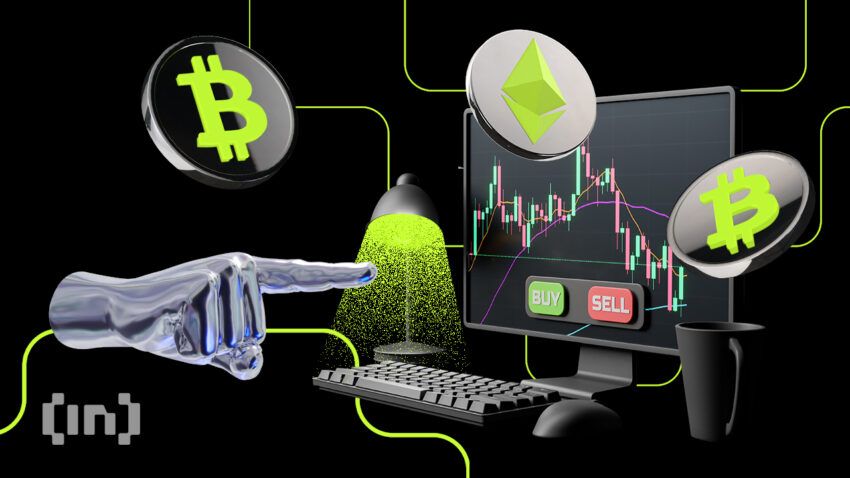The cryptocurrency market continues to maintain its bullish start to 2023. The 37% surge in total crypto market capitalization in 2023 has sparked global interest. Retail and institutional investors now seeking insights about price predictions for February 2023 and how the crypto market will behave in the immediate future.
Drawing insights from crucial on-chain data on Bitcoin, Ethereum, and other cryptos, here are the biggest cryptocurrency predictions for February 2023.
Can Bitcoin Maintain Its Dominance and Price Surge in February 2023?
The Cryptocurrency market cap reclaimed the $1 trillion mark in January after lurking below $800 billion for the better part of the second half of 2022. The resurgence has been largely driven by the strong performance of BTC in January.
Slowing inflation and increased institutional demand all played key roles as Bitcoin domination gained 3% to reach a 7-month high of nearly 45%.
Similarly, the ETH/BTC price ratio has shown that Bitcoin has gained 30% over Ethereum within the same period. This shows that investors remain firmly gravitated toward Bitcoin so far in 2023.
The short-term bullish trend in Bitcoin dominance index has perennially displayed a positive correlation with uptrends in altcoin prices and the global crypto market cap. And conversely, huge drops in BTC dominance have also been synonymous with major downward crypto trends.
Bitcoin Holders Predominantly Hold between $22,000 – $23,000 Price
Bulls had predicted a run-up towards $25,000 in February. The wider crypto industry is poised to maintain its coveted $1 trillion valuation. Particularly if BTC holds its key $22,500 support point.
Of the 5 million unique on-chain wallets monitored by IntoTheBlock IOMAP data sources. 36% of BTC holders In The Money are currently clustered around the $22,000 – $23,000 support point.
IOMAP stands for “Input-Output Market Analysis” or “In/Out of Money at Price” and is a technique used to make predictions about future crypto prices based on the unrealized profit or loss positions of the distribution of tokens holders on a blockchain network. Historically, Holders are most susceptible to selling off their tokens once the price hits their average break-even point.
Investors use IOMAP to identify crucial price levels where large buy or sell orders are likely to be placed by comparing the average cost of tokens held in specific wallets to the current Bitcoin market prices.
However, Bitcoin may face strong resistance in its march toward the $25,000 mark. Also, a sudden surge in Hash Rate and Bitcoin transaction fees could pose a serious threat to BTC dominance in February.
Bitcoin Hash Rate Spike May Trigger Another Miner Sell-Off in February 2023
Bitcoin Hashrate is rising due to soaring BTC prices which have caused more miners to swiftly join the network. The hash rate measures the total computing power used to mine a block of Bitcoin. It has soared by over 25% reaching an all-time high of 295m terahashes per second on January 30.
Bitcoin’s hashing power signals its resistance to attacks. This offers a consistent rise in mining difficulty and also means that miners now have to compete for limited block rewards.
Mining difficulty is predicted to reach a new all-time high in February as even more miners begin to fire up their machines. Especially if Bitcoin continues to maintain its bullish trend.
However, the trading activity of Bitcoin miners could also significantly slow down the ongoing bullish trend. Miners currently hold around 10% of the total BTC in circulation. This means that the trading activity of miners is a significant driver of price trends in the short run.
On-chain data currently shows a 185% net decline in the balances of top miners over the last 30- days.
Mining Costs Climb Again
Historical data on Miner reserve balances— a metric that monitors the aggregate balances of addresses belonging to notable mining pools. i.e f2pool, Binance, Antpool, Viabtc, etc. —shows that large miners prefer to accumulate their block rewards during a bull run.
MacroMicro, a Cambridge University-affiliated analytics platform, provides Bitcoin mining cost data. By observing the global consumption of electricity and daily issuance of bitcoin.
However, the Average Cost of mining a block of bitcoin surpasses the BTC/USD price. Miners are incentivized to shore up their reserves. If the price of BTC is able to scale over the $25,000 mark, miner sell pressure could ease up significantly. Miner accumulation will put BTC in good stead for a sustained bull run in the first quarter of 2023.
Bitcoin NFTs May Push Transaction Fees Higher
Bitcoin transaction fees are on the rise. This is due to a newly-launched protocol enabling bitcoiners to mint hundreds of non-fungible tokens (NFTs) on the Bitcoin network for the first time. Previously, most NFT collections have primarily been issued on Ethereum and other EVM-compatible networks.
Ordinals, a bitcoin-native NFT protocol launched in January has sparked a fee surge on the leading crypto network as hundreds of users start to mint digital artifacts.
Following the launch of Ordinals on Jan 21, 2023, average transaction fees on the Bitcoin network spiked above $1.50 as competition for block space hots up.
Bitcoin Average Transaction Fee measures the average fee in USD for each transaction processed by miners. Average Bitcoin transaction fees can spike during periods of congestion on the network, as they did after the launch of Ordinals.
The fee spike has sparked a feisty debate in the Bitcoin community amid predictions of scalability issues and competition for block space.
Bitcoin transaction fees are largely determined by the size of a transaction, and the demand for block space. The Ordinals platform grows in popularity, it is expected that competition for block size will spark a sustained increase in transaction fees. This could see Bitcoin slightly lose Dominance points in February as transactional users begin to switch to alternative networks to avoid paying huge fees.
Still, many Bitcoin developers have thrown their weight behind the NFT platform citing its potential to expand the network’s utility and boost the adoption rate.
Ethereum Will Close February 2023 with Net Decrease in Supply
Ethereum effectively became deflationary following the completion of the Merge and the implementation of Ethereum Improvement Proposal (EIP)-1559. EIP 1559 enables a mechanism for gas fees paid for transactions on the network to be burned.
The burn mechanism is tied to the intensity of transactions on network usage. This means the more transactions on the blockchain, the more ETH is burnt.
Data shows that the increase NFT transactions across platforms such as Opensea is responsible for the recent uptick in ETH burn.
Ethereum PoS Has Burned $108 Million so Far
According to on-chain data provided by Ultrasound Money, more than 65,000 ETH have been burned since the turn of the year. OpenSea currently topped the Burn Leaderboard in January with ~5,000 ETH burned.
NFT transactions have been known to move in correlation to crypto markets’ price trends. If Bitcoin and the rest of the crypto market sustain the bullish outlook, ETH could lose February in a Net-negative supply position.
However, this is not expected to create a break-out in the ETH prices in February as on-chain data suggests that the investors have already priced the deflationary stance into the current valuation.
For Ethereum to experience a significant price surge, the network must find new demand. The lack of new demand for the second-largest crypto by market cap was depicted by the persistent decline in Open Interest over the past ten days. Data culled from Coinglass revealed. ETH’s Open Interest fell by 16% within that period.
Typically, the decline in Open Interest means that fewer new contracts are being created as investors close out their current positions.
It is also worth mentioning that, in March, Ethereum will undergo the much-anticipated “Shanghai Upgrade” —its first big hard fork since the proof-of-stake transition in September. Once the EIP-4895 hard fork is completed, 16 million staked ETH will finally become withdrawable by the validators that help secure the network.
Fears of a massive dump, heralded by the anticipation of the 16 million ETH liquidity re-injection, could see ETH deliver a flat performance in February —even as the rest of the crypto market continues to rally above 12-month highs.
Anticipate Massive Whale Action in February 2023 as XRP vs SEC Ruling Looms
The Ripple (XRP) vs SEC legal battle has entered its third year. As the legal proceedings may draw reach a definitive close in February, speculation about the outcome of the case has intensified.
The ruling is eagerly anticipated by the crypto community as well as the traditional financial industry —as it could set the tone for how digital assets will be regulated in the future.
A verdict could determine whether crypto assets will now be categorized as securities or not. A victory for SEC could spell a massive bearish turn in the XRP prices, with Institutional investors also likely to drastically reduce their exposure to crypto assets in a bid to avoid regulatory sanctions in the long term.
On-chain crypto data provided by Santiment currently suggests that investors anticipate a positive price action in the aftermath of the ruling. The funding rate for XRP is positive across top exchanges. While social sentiment measured by taking stock of XRP media attention across popular crypto online channels, revealed a spike in positive sentiment for the altcoin as the court ruling draws closer.
To conclude, both Ripple executives and the SEC representatives expressed confidence in their chances of success. However, a recent poll conducted by U.S. lawyer John Deaton has pointed out that the majority of the XRP community are pinning for a settlement rather than a victory verdict for either party.
Trusted
Disclaimer
In line with the Trust Project guidelines, this price analysis article is for informational purposes only and should not be considered financial or investment advice. BeInCrypto is committed to accurate, unbiased reporting, but market conditions are subject to change without notice. Always conduct your own research and consult with a professional before making any financial decisions. Please note that our Terms and Conditions, Privacy Policy, and Disclaimers have been updated.

